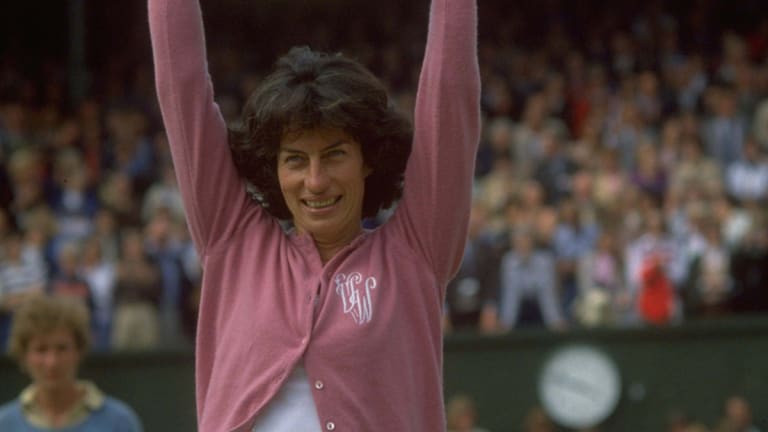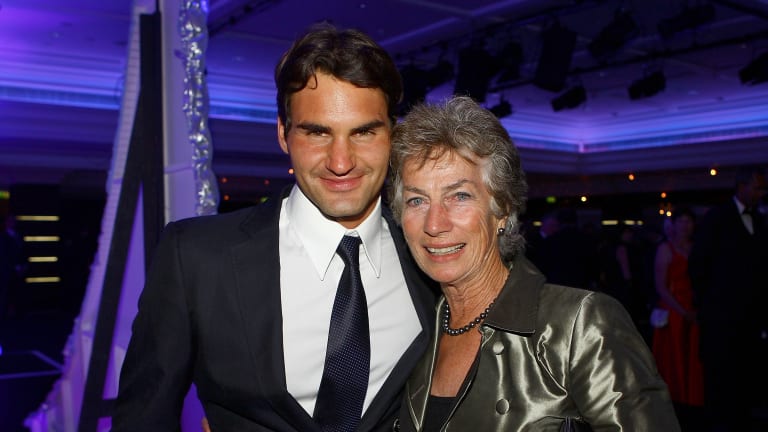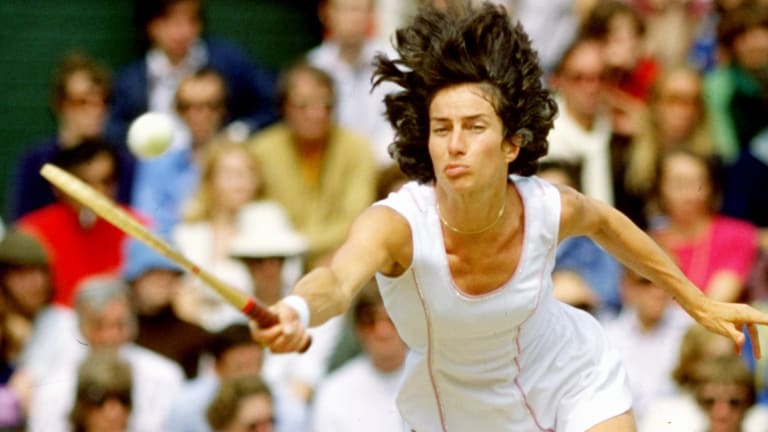The Queen and I: Virginia Wade's 1977 Wimbledon win was meant to be
By Steve Flink Jun 30, 2020Wimbledon to replace line judges with electronic line calling from 2025
By TENNIS.com Oct 09, 2024The amazing journey of Henry Patten from IBM data logger to Wimbledon doubles champion
By TENNIS.com Jul 16, 2024Hsieh Su-Wei, Jan Zielinski win mixed doubles title at Wimbledon
By Associated Press Jul 15, 2024Why Wimbledon Endures
By Peter Bodo Jul 15, 2024Novak Djokovic seeks 2024 answers for Alcaraz and Sinner after great effort: 4 ATP Wimbledon takeaways
By Joel Drucker Jul 14, 2024Carlos Alcaraz is a champion establishing how high he will climb with latest Wimbledon title
By Steve Tignor Jul 14, 2024Nicolai Budkov Kjaer makes history in winning junior boys' Wimbledon title; Renata Jamrichova wins girls' title
By Associated Press Jul 14, 2024Carlos Alcaraz beats Novak Djokovic again in Wimbledon final for fourth Grand Slam title
By TENNIS.com Jul 14, 2024For Jasmine Paolini, Barbora Krejcikova was one forehand and one serve too good in the Wimbledon final
By Steve Tignor Jul 13, 2024The Queen and I: Virginia Wade's 1977 Wimbledon win was meant to be
With the knowledge of a royal presence, the Brit thought, "Well, if she is going to be there, I better be there. And if I am there I better win."
Published Jun 30, 2020
Advertising
In many ways, Wimbledon was synonymous with Virginia Wade for a very long time. The evocative Englishwoman played at the All England Club for 24 consecutive years, from 1962-85. All through her playing days, loyal crowds followed her every move, emoted with a fervor they exhibited unabashedly, and gave her their undivided attention. To the fans of Great Britain, Wade was a performer with a singular hold on their outlooks and imaginations.
Wade told me in a recent interview about the powerful connection she had with the crowds all through her career—and especially during her enormously popular 1977 triumph on the lawns of London.
“Playing there is an unbelievable feeling. If you are feeling good about yourself, it is like riding a wave, but if you are not feeling great it is like being dumped in the sand and not being able to breathe,” she says. “You have to try to enjoy it even if it does also come with its toll. But 1977 was amazing with the extra motivation of it being the queen’s Silver Jubilee and the Centenary of the club. I was amused the other day by a BBC poll of the most memorable female athletes. Believe it or not even all these years later, I came in fourth.”
Watching Wade compete at Wimbledon was an annual ritual for her legion of admirers, and at long last they were rewarded for their unwavering loyalty in that memorable 1977 grass-court festival across a fortnight. Wade was seeded third in her 16th attempt to prevail at the tournament she wanted more than any other. She reached the quarterfinals without dropping a set, and then ousted sixth seeded Rosie Casals 7-5, 6-2. Casals had defeated Wade in their last two head-to-head meetings that year, but it didn’t matter.
“It’s funny that you bring that up,” she says. “Rosie was very tough but I thought I was a slightly more complete player than she was. When it came to Wimbledon, it was not a bad thing having lost to somebody like I had to Rosie because you are extra motivated to correct that. You focus much harder.”
Having settled that score, Wade faced top-seeded Chris Evert in the semifinals. Evert had come off victories over Tracy Austin and Billie Jean King. She was the clear favorite and held a 22-5 career lead over Wade. But this time Wade was ready.
As she recounts, “I managed against Chris to stick to a game plan. My coach Jerry Teeguarden was strict about that. He would say to me, ‘I have seen you play Chris Evert perfectly so many times but you get ahead and then you change your game plan.’ I knew that anything I got that was even halfway short from Chris—and you know how accurate she was—I had to take the nearest opportunity to play my best approach shot which was my crosscourt backhand slice. That played into her strength on the two-handed backhand, so I had to get her out to the forehand first and then approach on her backhand.”

The Queen and I: Virginia Wade's 1977 Wimbledon win was meant to be
Advertising
Wade after her 1977 Wimbledon victory. (Getty Images)
Wade took the opening set from Evert before the Floridian retaliated to win the second. But the home favorite's third-set performance was singularly dazzling. She was victorious 6-2, 4-6, 6-1.
“I knew the crowd would be on my side,” she recalls, “The grass was good for me. I liked the way I was hitting my sliced backhand. I knew what I had to do. I was not surprised it went three sets. Heavens, this was Chris Evert, and she was No. 1 in the world. But you can get into the zone. You are playing well and not thinking too much. That is what happened to me in the third set against Chris.”
And so Wade was into her first Wimbledon final. The other semifinal pitted her countrywoman Sue Barker against Dutchwoman Betty Stove. Wade had a commanding 16-3 record against the streaky yet brilliant Stove, although she often had to fight inordinately hard to win those contests. Barker, meanwhile, was playing the finest tennis of her career and had stopped Wade three times in a row earlier in the season. Barker had one of the biggest forehands of her time and a fearless outlook to boot.
“Deep down I did not really relish playing Sue because she was another British player,” Wade says. “I didn’t watch their match, but when I found out the result I was relieved it wasn’t Sue who won. I knew if I was playing Betty, I would have the support of the crowd. If I had played Sue, it would have been agonizing for the crowd watching two British players. I had fought through to win so many close matches with Betty, so I knew I had earned the right to beat her in a big one.”
Elaborating on that point, Wade says, “I really believe that about earning your right to win. You don’t just go into a Grand Slam final and put on a Turbocharger and play. You have to beat people in less significant moments. So I felt Betty would have trouble beating me, even though I didn’t enjoy playing her. Her serve was so difficult to return and you never got any rhythm against her. None whatsoever. She was not the sort of player that I wanted to lose the first set to. I can tell you that. But I did.”
Stove was exceedingly dangerous at that time. Not only did she overcome Barker in a hard-fought yet nerve-wracking semifinal battle, but she had halted No. 2 seed Martina Navratilova in the quarters. Navratilova would take her first of a record nine titles the following year.
Wade did have serious problems with the Stove serve in that opening set. Stove was one of the tallest WTA players of her time and her delivery was explosive. Wade, however, had a smoother and more elegant motion. Arguably her serve was the best in the women’s game and also among the biggest.

The Queen and I: Virginia Wade's 1977 Wimbledon win was meant to be
© 2009 Getty Images
Advertising
Eight-time Wimbledon champion Roger Federer and Wade attend the 2009 Wimbledon Winners Party. (Getty Images)
Nevertheless, Stove set the tempo in the first set before Wade grabbed an early lead in the second. But before she knew it that set was locked at 3-3.
“I had gone up 3-0 and I could not believe she got back to 3-3,” Wade says. “Everybody was getting really nervous. In this particular case, I had to believe in myself and feel in the end I was going to beat her. I just played out of my mind in the third set. I was oblivious to everything and on such a high. I remember chasing a ball I had no right to get on my forehand. I slipped on the grass and was flat on my backside, but it was sort of funny. I thought I could do anything in that third set. It is certainly nice to hit your stride at the right time.”
Wade collected nine of the last ten games to win, 4-6, 6-3, 6-1. She says of her richly rewarding triumph when she was nearly 32, “It really is quite something because you have struggled for so long and then you manage to do it. And I managed it not only with my tennis and physical aspects, but also because I knew how to control my nerves and play better tactically. In other words, I was much more professional, so putting the plan into effect was satisfying.”
Just as gratifying was celebrating her finest hour as a tennis player in front of Queen Elizabeth II on a stage she cherished. Wade had said in advance when she heard the queen would be present for the women’s final that she made up her mind then she was going to win the tournament. But that lofty goal could have been crippling rather than inspiring.
“In the end,” she says, “if the motivation can override the tension you have got a pretty good chance of doing well. In this particular case where there was always so much tension for me playing at Wimbledon, I think knowing that the queen was going to be there made me feel, ‘Well, if she is going to be there, I better be there. And if I am there I better win.’ So it was quite simple. The overriding motivation sort of guides you through.”
But a part of her believes that at long last she was destined to succeed that year.
“You can think that if the queen is going to be there that is the way the stars are aligned,” she says. “I do believe that to an extent. I certainly know that as a tennis player you keep trying to make the stars align. You keep trying to do things that are going to make you think it is the right time and place. So it is a little bit of fictitious fate I would say.”

The Queen and I: Virginia Wade's 1977 Wimbledon win was meant to be
Advertising
Wade en route to her first title at the All England Club. (Getty Images)
The fact of the matter is Wade joined the list of eminent players who have come through at Wimbledon for many reasons. She had believed for a couple of years that she was ready to do it.
As Wade explains, “I lost this quarterfinal match to Evonne Goolagong [Goolagong won 5-7, 6-3, 9-7] two years earlier. I could not have played better. Evonne was a slick campaigner who could always come up with some magic tricks in the critical moments at the end of matches. I could not blame myself for that loss. I thought then that I was ready to win Wimbledon.”
Prior to her contest with Stove, Wade received a note from Arthur Ashe wishing her well. As she remembers, “He wrote something like, ‘Camp out at the net and you will be all right.’ That was so nice. We did not move in the same circles, but he was always doing such important things beyond his tennis. It would have been really cool to speak with Arthur these days.”
The parallels between Ashe and Wade were extraordinary. Both were born on July 10. They were the first US Open champions in 1968. They each won their second major at the Australian Open. And both players crowned their careers by emerging victorious at Wimbledon when they were nearly 32 years of age. Moreover, Wade and Ashe—both dynamic, adventurous and unpredictable— kept their often-exhilarated and sometimes exasperated fans on the edge of their seats.
“Sharing the same birthday with Arthur was the real link between us,” says Wade. “I didn’t connect with him as much as I would have liked, but I was always aware of our parallels and I will never forget Arthur’s victory over Jimmy Connors in the 1975 Wimbledon final.”
Nor will Wade ever forget her own incomparable Centre Court triumph in 1977. She put a shining capstone on her career, and nothing could have been more fulfilling than that.
As she says, “It made everything else worthwhile. If I had not won Wimbledon, I would have had some misgivings about my career, but managing to put it all together and win Wimbledon while really knowing what I was doing out there was very satisfying. I went from A to Z through all of it. Winning Wimbledon was definitely the capstone of my career.”

The Queen and I: Virginia Wade's 1977 Wimbledon win was meant to be